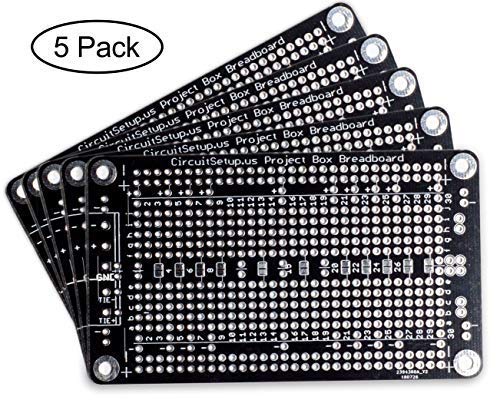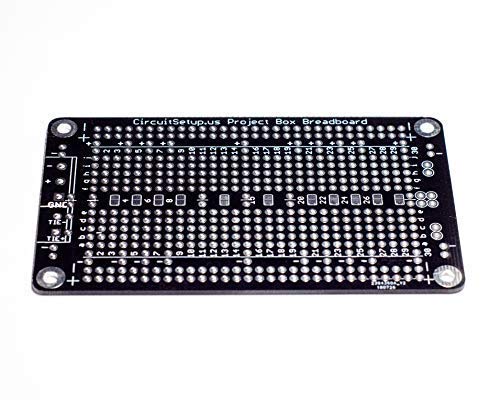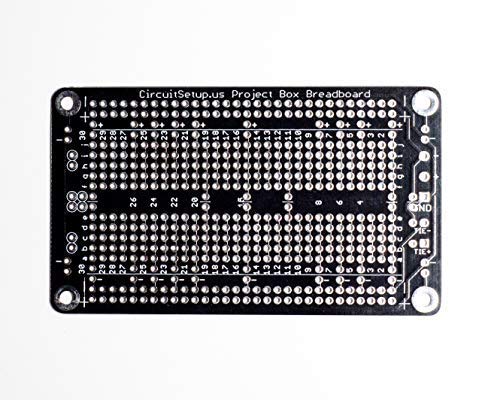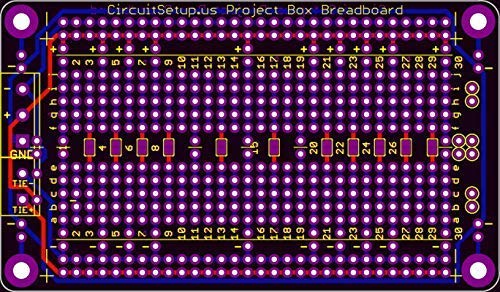




This solderable breadboard is made to be easily configured with minimal soldering. It features: - Holes for 2 & 3 pin screw terminals that are connected to power rails - Power rails can be tied together or can be separate for different voltages - Screw holes can be tied to ground - Additional holes next to the rails, at the end of rows, and in the middle of the board for easily placing connectors, components, or tying together power rails and rows - Holes on opposite end for connectors, switches, LEDs or whatever else you would like - Solder pads in the middle of the board to tie rows together - Comes in packs of 5
M**D
A great board for some projects
I tried the SparkFun and this board and like this one better. It has a few simple features that make sense. For what it does, it does great.This may well be the best solution available to many hobbyists wanting to turn a breadboarded idea into something that will hold up. Not many hobbyists can afford to build a custom board. And this one lets you skip the step of even drawing a circuit diagram once you have your circuit working on a breadboard.My hesitation is that the concept is problematic. Compared to a real circuit board, this approach has you making a lot more solder joints. For example, you have to solder in all your jumper wires. Plus, the solder joints you do need to make are tricky. Everything is on a grid and it takes some skill to solder joints that end up being so close together.I will continue to use these but I'm also planning on learning how to use the board-making tools at my local Makerspace. If you have access to such a facility, I recommend that as well.
P**N
Super easy fit into a project box; black
These are actually really nice little boards. As seen in the "frequently bought together" section, these fit into the project box listed and line up perfectly with the screw holes therein. The boxes aren't super quality, but they ARE super cheap, so it made sense to me to get a 5-pack of these boards and a 5-pack of the boxes. No listing anywhere says what screw size to use, but I see 2.5mm is standard standoff size for Pi and Arduino, so I'm going with that.I haven't actually gotten around to using the boards yet, but I've inspected them closely and they'll definitely work for my microprocessor projects. Really happy I don't have to make boards!
J**Y
Improved power layout and good solderability.
Circuit boards are well made and solder well. I normally prefer gold-plated boards but I have not had any problems. Good, quick circuit building. They have a couple of "added" features that should catch on. Like the offset + and - connectors (off the usual power tracks). Took me a while to learn how to make good use of them but they can be useful. Good sized mounting holes and a noticeably rigid PCB. Nice Value is good and the reduced dimensions can be helpful. Cheap enough for jelly bean use.
D**L
My favorite
By far my favorite proto boards - many little conveniences that help cut down on the number of jumper wires required. Fits smoothly into project boxes (like this one: B07S4L1NHH).Would be great if they made a similar full-size one, or even a double side-by-side full-size one!
B**R
Best proto board available today
I've used several of these on projects over the last year. Breadboard style traces are essential for quick soldering of connections. There are 2 independent power busses on the sides. I often have both 3.3v and 5v on the same board. A jumper pad is provided to join them together if you want. The boards are thick and stiff, no flexing issues.They are not very big, applicable for modest projects as the microcontroller will consume most of the space. You can of course stack them, but that's more work. The good news is you can easily cut the breadboard traces on the back side with an Exacto blade to get more usable connections.
W**A
Good solder-able board with use limitations
These boards will not fit in most project boxes with size ( 9.6 x 5.6 x 2.3 cm/ 3.78 x 2.20 x 0.91 inches inner dimension). Requires grinding all sides to fit in project box.
T**G
Good for prototyping
Fits into the black boxes you can find on Amazon of the same size. I found no trouble soldering with these boards. They pretty much work like the plastic breadboards as far as which holes are connected. They have two convenient tie locations to tie either the negative or positive side rails together.
D**R
Been looking for this sort of thing for a long time
Translating from breadboard to proto board can be such a pain - these things solve that & save so much hassle.
Trustpilot
3 weeks ago
2 days ago